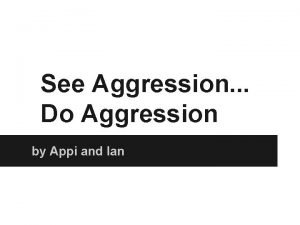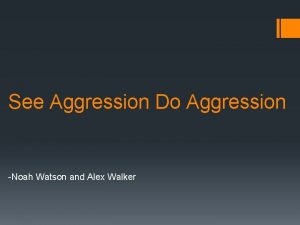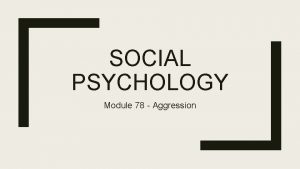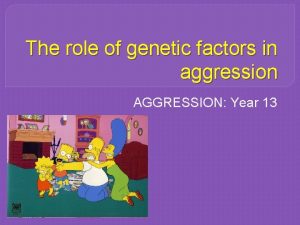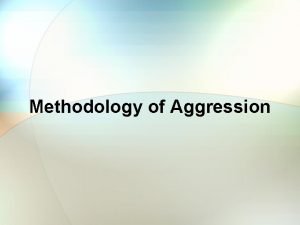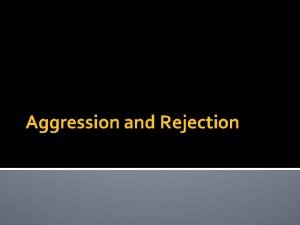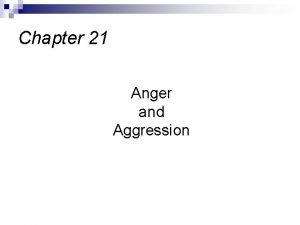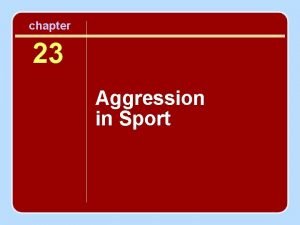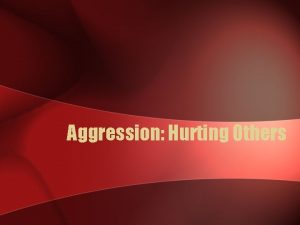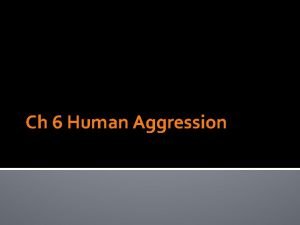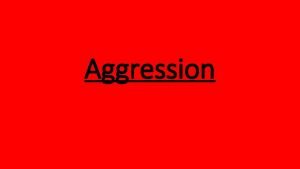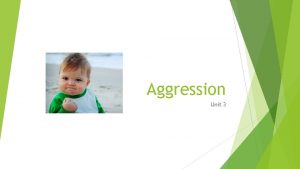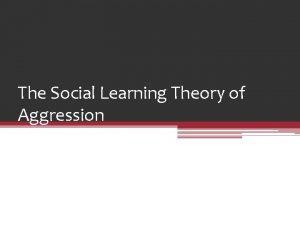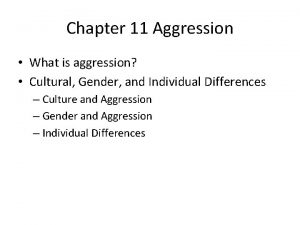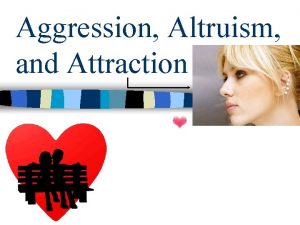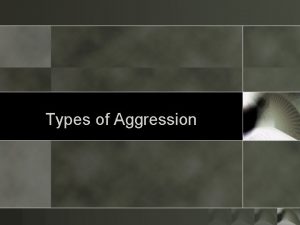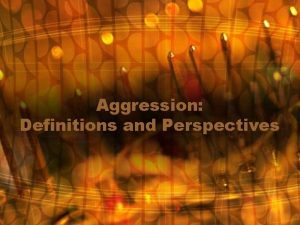Review your summary sheet for aggression A 2





















- Slides: 21

Review your summary sheet for aggression

A 2 Physical Education Sport Psychology AGGRESSION AND CONFIDENCE Week 3 Revision

Aggression vs assertion “Any behaviour that is intended to harm another individual by physical or verbal means. ” (BULL) “Any form of behaviour directed toward the goal of harming or injuring another human being who is motivated to avoid such treatment. ” (BARON) HOSTILE AGGRESSION Main aim is to harm and inflict injury. Aggressive actions are outside the rules of the game ‘Hostile destructiveness’ (PARENS) Hostile aggression involves anger. This type of aggression needs to be eliminated from sport! ASSERTIVE BEHAVIOUR No intention to harm. Strictly within the rules and spirit of the game. Robust, but functional play. Primarily focused on completing the skill successfully. ‘Non-hostile selfprotective mastery behaviour’ (PARENS, 1987)

Not needed INSTRUMENTAL AGGRESSION Intends to harm as a means to another goal. For example if you rugby tackle an opponent with force the intent to wind them CHANNELED AGRESSION Positive form of aggression, divert feelings into positive actions. For example working harder

Antecedents of Aggression HOSTILE CROWDS NATURE OF THE GAME WIDE DIVISION BETWEEN SCORES FRUSTRATION CAUSED BY POOR PERFORMANCE, OPPOSITION OR REFS DECISIONS. AGGRESSION PREVIOUSLY DEVELOPED GRUDGES OR SCORES TO SETTLE VENUE…AWAY TEAM HIGH AROUSAL LEVELS EXTRINSIC REWARDS

Theories of Aggression INSTINCT THEORY (TRAIT PERSPECTIVE) - Proposed by FRUED but developed but LORENZ in 1966. - ‘Aggression is genetically inherited and that trait of violence lies within everyone due to a basic instinct to dominate. ’ - ‘Death instinct’ (FREUD) - ‘Aggressive energy is constantly building up and needs to be released’ (LORENZ) FRUSTRATION AGGRESSION HYPOTHESIS – INTERACTIONIST PERSPECTIVE - Proposed by DOLLARD. - ‘Frustration develops when goal-directed behaviour or NACH is blocked. ’ -It is instinctive to fulfil the need to release frustration. - Instinct theory – aggression is the goal. - Aggression = successful = catharsis - Aggression = unsuccessful = more frustration SOCIAL LEARNING THEORY - Proposed by BANDURA, 1966 but developed by LEAKEY. - Aggression is not biologically based but is nurtured through environmental forces. - Learned by watching and copying role models and it becomes an excepted mode of behaviour if reinforced. AGGRESSION CUE HYPOTHESIS (BERKOWITZ, 1969) – INTERACTIONIST PERSPECTIVE - Builds upon DOLLARD’S work. -Frustration leads to an increase in arousal which, in some situations will result in aggression. -Cues = baseball bats, violent acts being witnessed, nature of the game will trigger aggression if arousal is high. -Best players have the ability/temperament to control frustration and arousal.

Do they have limitations? INSTINCT THEORY (TRAIT PERSPECTIVE) SOCIAL LEARNING THEORY FRUSTRATION AGGRESSION HYPOTHESIS – INTERACTIONIST PERSPECTIVE AGGRESSION CUE HYPOTHESIS (BERKOWITZ, 1969) – INTERACTIONIST PERSPECTIVE

Reducing and controlling aggression Ø Ø Ø Ø Ø Punish aggressive play. Withdraw violent players from the situation. Stress performance rather than the outcome. Emphasise non-aggressive role models. Make use of cognitive strategies to prevent aggressive play. Positively reinforce non-aggressive behaviour and negatively reinforce aggressive behaviour. Change athletes perceptions of the situation. Implement stress management techniques. Lower arousal levels

Aggression – traffic light sheet Anything new that I’ve learnt

Confidence Book 2 page 94 – 100 ¡ Self confidence and self efficacy. What is the difference?

Review your summary sheets ¡ Trait and state confidence

Bandura’s model

Vealey's model of self confidence Page 95 – OCR 2015

Social Facilitation/Inhibition SOCIAL FACILITATION: The presence of an audience positively increases arousal levels and performance is enhanced. SOCIAL INHIBITION: A negative effect on performance is experienced due to the attendance of an audience.

Simplified diagram

Improving confidence pg. 99

Social Facilitation/Inhibition Homefield Advantage: Strategies to Combat Social Inhibition: -Large supportive home crowds have a positive effect on performance. - Practice selective attention. - Most evident in indoor sports such as basketball. - Crowd gets close to the action, increasing audience influence. This is called the ‘proximity effect. ’ - Use imagery, mental rehearsal to block out audience effects. - Ensure essential skills are overlearned and grooved. - introduce evaluative others into practice. - Raise athletes’ awareness of the zone of optimal functioning. - Incorporate stress management into training. - Appropriate use of attribution

Home and away Advantages Disadvantages

Strategies to eliminate effects

Confidence– traffic light sheet Anything new that I’ve learnt

Next week Week 1 Aspects of personality Arousal Week 2 Controlling anxiety Attitudes Week 3 Aggression Confidence Week 4 Attribution theory Group success Week 5 Leadership and any questions
 See aggression do aggression
See aggression do aggression See aggression do aggression
See aggression do aggression Give us your hungry your tired your poor
Give us your hungry your tired your poor Stock verification sheet is also known as
Stock verification sheet is also known as Kontinuitetshantering
Kontinuitetshantering Typiska novell drag
Typiska novell drag Tack för att ni lyssnade bild
Tack för att ni lyssnade bild Ekologiskt fotavtryck
Ekologiskt fotavtryck Shingelfrisyren
Shingelfrisyren En lathund för arbete med kontinuitetshantering
En lathund för arbete med kontinuitetshantering Underlag för särskild löneskatt på pensionskostnader
Underlag för särskild löneskatt på pensionskostnader Personlig tidbok fylla i
Personlig tidbok fylla i Sura för anatom
Sura för anatom Förklara densitet för barn
Förklara densitet för barn Datorkunskap för nybörjare
Datorkunskap för nybörjare Boverket ka
Boverket ka Mall för debattartikel
Mall för debattartikel Delegerande ledarstil
Delegerande ledarstil Nyckelkompetenser för livslångt lärande
Nyckelkompetenser för livslångt lärande Påbyggnader för flakfordon
Påbyggnader för flakfordon Formel för lufttryck
Formel för lufttryck Svenskt ramverk för digital samverkan
Svenskt ramverk för digital samverkan
